Eyebrows were raised over the swift appointment of Barcelona legend Xavi, following Ronald Koeman’s departure in October 2021. Yet, fifteen months into the Spaniard’s tenure at Camp Nou, Xavi has reinvigorated the fanbase with beautiful possession-oriented football. Barca have picked up 59 points from twenty-two games so far in La Liga, and are running away with what would be the club’s first league title in four years. This, even despite the horrors off the pitch captivating the media’s attention. Here is our analysis of Xavi’s Barcelona in 2022-23.
xAVI’S ‘4 P’S’
Embed from Getty ImagesOn Paper, Xavi’s team sets up in a 4-3-3 formation, with Sergio Busquets acting as the side’s central pivot. Busquets has been an ever-present even since the days of Xavi’s tenure as a player himself, and continues to hold strong in the centre of the park. Elsewhere on the pitch, Xavi has remained consistent in his eleven. Despite this, only Marc-André ter Stegen has started every game so far, highlighting how his small squad of nineteen first team regulars can be rotated where necessary.
Tactically, he’s ingrained four key principles into the squad – what he’s deemed the ‘Four P’s’. Those are ‘positioning, possession, pressure and perception’.
Embed from Getty ImagesPositionally, the Spaniard doesn’t expect anything too complicated, instead aiming for an organized structure that his side can build around. Each teammate must be aware of the positioning of others, and in achieving this, continuous scanning and the ‘P’ of ‘perception’ remain imperative to the process. Each of the potential heirs to Xavi’s throne are excellent in this department – from Gavi to Pedri to Frenkie de Jong. He simply has a conveyor belt of world class midfielders at his disposal, each of whom perfectly exemplify the Barcelona way.
Embed from Getty ImagesWhen it comes to possession, Xavi wants to dominate the ball. There’s no other way when it comes to Barcelona, and this is something that the Spanish legend embodied himself as a professional. The Barca manager takes a similar approach to his former manager Pep Guardiola when it comes to keeping the ball, believing that it’s better to develop rhythm and slowly build attacks, rather than always counter attacking guns a blazing after winning the ball. Xavi recognizes that the best time to catch the opposition in limbo may be on the break, but also recognizes the risk in playing forward too quickly, and pulling one’s own shape out of order in the quest to counter.
Possessing comfortable ball-playing defenders in behind that elite lineup of midfielders makes keeping possession all the easier for Blaugrana. Andreas Christensen has completed more passes than any other player this season, whilst Eric Garcia has continuously displayed his competency in playing long passes out from the back.
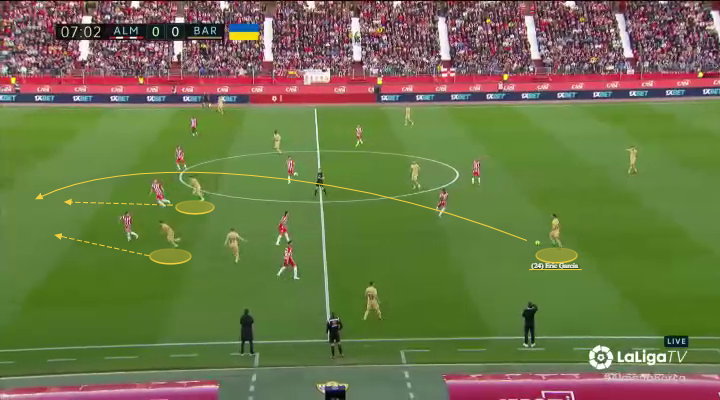
Frenchman Jules Koundé even adds the necessary composure out from the back, as more of a possession-oriented, defensively minded fullback. This also helps in creating balance down the other side, where Barça are far more likely to play a high-flying wing-back like Alejandro Balde, Jordi Alba or Marcos Alonso to receive those diagonal long passes.
But Xavi’s ‘P’s’ don’t stop at possession and position, there’s also a necessity to ‘pressure’ quickly after losing possession, ensuring they can keep the ball for long spells and dominate the match. The aim of their pressure is to force errors and ‘recover’ possession (through interceptions and forcing the ball out of play), rather than diving in and stealing the ball on a typical tackle.
Embed from Getty ImagesThe final ‘P’ manifests in the form of ‘perception’, where players must constantly be scanning the field and perceiving their surroundings with or without the ball at their feet. Busquets is one of the many masters of this art, continuously evaluating and adjusting his position to receive the ball and immediately play sound passes all over the field. ‘Perception’ has to be one of Xavi’s preeminent principles at the club, and enforced whenever speaking to the other three. The way that players perceive the moment allows them to better pressure the opposition, understand how and when to adopt various positions on the field, and how they can keep possession of the ball and progress at the right moments.
Embed from Getty ImagesAny coach has their own philosophy for how they see game, but it’s fantastic to see how Xavi has made his a clearly defined process that all players are able to buy into. Influenced by his own playing career, it’s simply the ‘Barcelona way’, beyond his own beliefs about the game. Now that he’s clearly communicated these principles to his players and achieved buy-in, the results are likely to follow.
Attacking Principles
Embed from Getty ImagesXavi’s Barca have been a rampant attacking force this season, scoring 2.05 league goals per game from 2.35 xG, the highest expected goals tally of any Spanish side. Surprisingly, they are scoring less than their chances warrant, suggesting how results can be maintained, if not improve as the season progresses.
Barcelona are content building the play slowly from the back and advancing the ball through the opposition’s press with caution. Many teams can get too slow passing the ball out from the back, and this has often been a criticism of teams like Barcelona over the years. However, Xavi’s side possess several of the best ball progressors in the world, each of whom are capable of breaking lines not only with swift passing, but dynamic carrying of the ball through gaps. Pedri and Frenkie de Jong for example have each completed over 8.00 progressive passes per game, whilst possessing the dynamism to drop the shoulder and dribble through gaps at any moment. The Dutchman’s even progressively carried the ball a greater distance (213 yards per 90) than any other midfielder in La Liga.
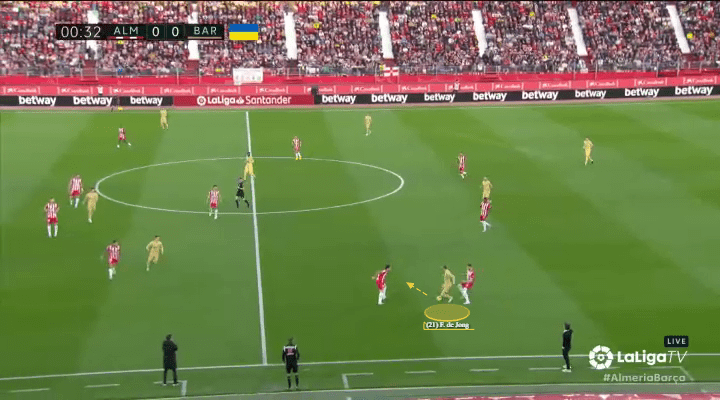
Beyond the talent, Xavi has implemented a fairly rigid build-up structure that most often manifests in a 2+3 diamond shape involving Busquets and ter Stegen. This is the most common approach for any team playing in a 4-3-3. However, it’s true that Koundé often plays a more reserved role, and that they can shift into more of a 3-2-2-3 as they progress up the field.
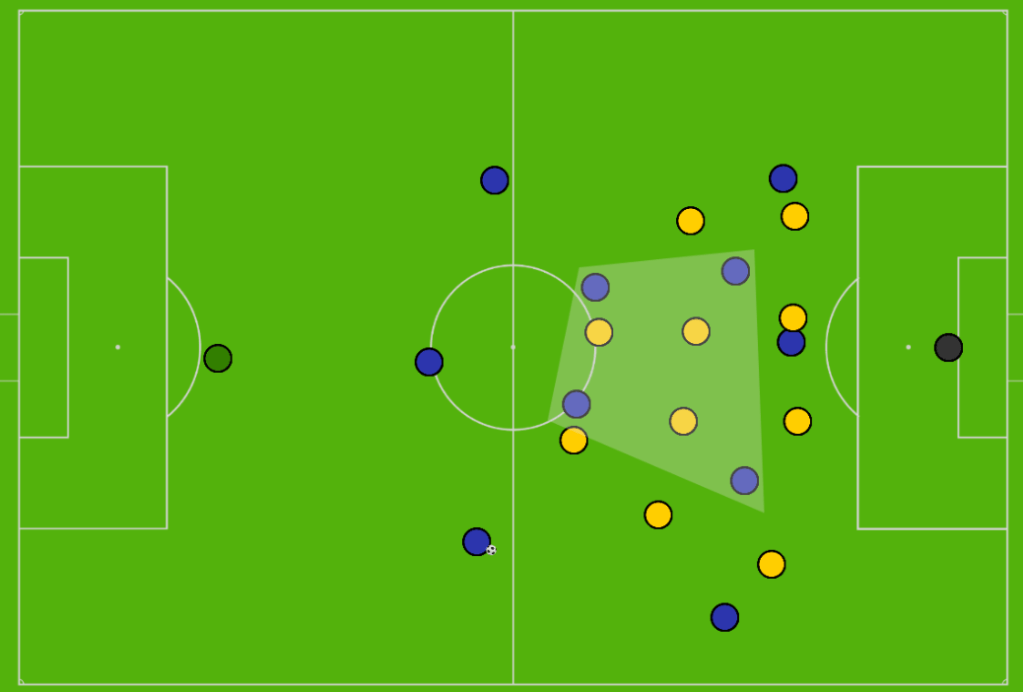
One central midfielder, often de Jong, will then float toward the side of the ball, helping to aid the numerical superiority. But if the opposition’s press becomes dangerous, ter Stegen has perfected the principle of perception, often playing a tricky pass over the first line of defence into one of Blaugrana’s half-space midfielders or a retreating Lewandowski.

As Xavi’s side make a move to sustain possession in the opposition’s half, Barca’s more familiar 3-2-2-3 takes shape. Gavi strays from his left wing role, taking up the left half-space position, complimenting Pedri’s role opposite him in the half-spaces. Both are phenomenally complete for midfielders of their age, having expertly mastered the positional play responsibilities held within Xavi’s system.
Embed from Getty ImagesTheir gaffer has unwavering trust in the two of them; proved by their increased playing time this season. Pedri’s even accumulated the most minutes of any outfield player at the club (82%).
Since Gavi will often like to drift inside from that left wing position, this is where someone like Balde or Alba can gallop forward and go on the overlap.

Down the other wing, they frequently have threats like Ousmane Dembélé and Raphinha, masters of La Pausa. Both dynamic dribblers are formidable at luring opponents into the tackle, before breaking away. Raphinha will even often play switches to the other side himself, while Dembélé sits third in La Liga for goals + assists per 90 (0.82), and leads the way for progressive carries per 90 (7.54).
Embed from Getty ImagesBut in between the wide isolations, their preferred method of creating chances is through the centre of the pitch (66% of their shots coming centrally), making good use of their box midfield. The midfielders’ positioning is fundamental to progressing the ball through the thirds and working the ball in behind for Lewandowski because of the high number of angles they create for the ball carrier.
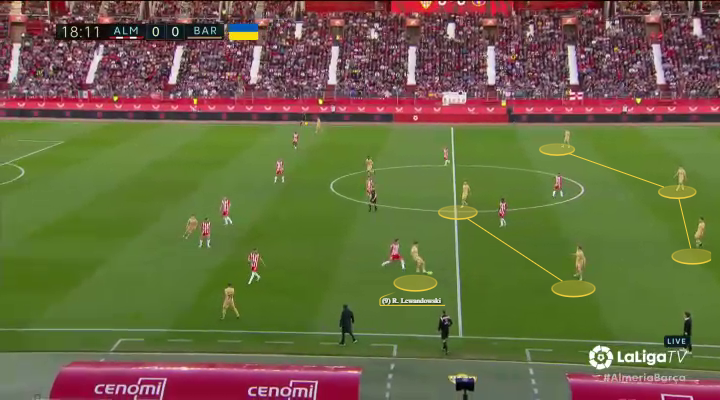
Lewandowski will even drop toward the ball as others sprint in behind, creating variety and pulling the opposition out of sorts. This makes progression of the ball through the centre all the easier, as many players remain in close proximity to form diamonds and play quick, short passes. Beyond vertical attacks, this level of close proximal connection has been crucial to keeping the third highest possession of anyone in Europe’s top five leagues this season.
If they can become even more fruitful in transition, Xavi’s team will be a difficult force to stop as the season progresses.
Defensive Principles
Embed from Getty ImagesOn the defensive end, Barcelona are on course for a historic, record breaking season. They’ve conceded just seven goals in twenty-two league games, currently on track to break the previous record help by Deportivo La Coruña in 93/94 (18 goals conceded).
Much of that comes from their steady possession and dominance of the ball, where they simply spend less time defending. ‘Pressure’ is one of Xavi’s ‘4’ ‘P’s’, but you’d probably guess that it ranks last in importance when compared to the other three. Nevertheless, Barca’s counter press has been aggressive and effective, with the third most tackles in the final third this season, despite spending so little time out of possession. They even rank fourth for recoveries per 90 (54), highlighting the emphasis placed on quickly regaining possession.
Embed from Getty ImagesXavi sets his ‘in possession’ shape up to retrieve the ball back like a pack of wolves when they are dispossessed. The diamond shapes and close proximal connections aids in the team’s endeavours to immediately win back possession, ensuring they can swarm around the situation.
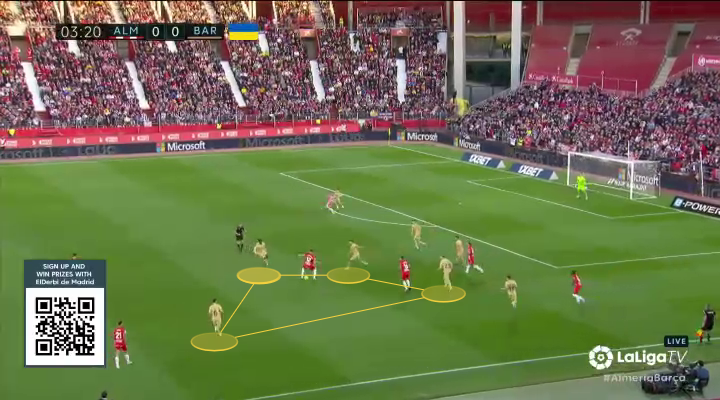
Additionally, using a double pivot in front of their back three out from the back means they have a sound rest-defense in place to shuttle the ball into the wide areas and limit counter-attacks. It even means that if someone like Koundé then needs to step up, Busquets or de Jong can comfortably take his place in the structure as another midfielders falls back into shape.
When pressing from the front, Barcelona display relatively relentless energy, with the likes of Lewandowski and Raphinha firmly familiar with pressing ideologies from former sides and former managers. The team have allowed the least passes per defensive action (7.32), with Raphninha and Dembélé leading the aggressive charge right from the front. Full-backs then remain ready to step up to the close the wide areas if the wingers are beaten, ensuring Barca have a conveyor belt of pressure toward winning back possession.
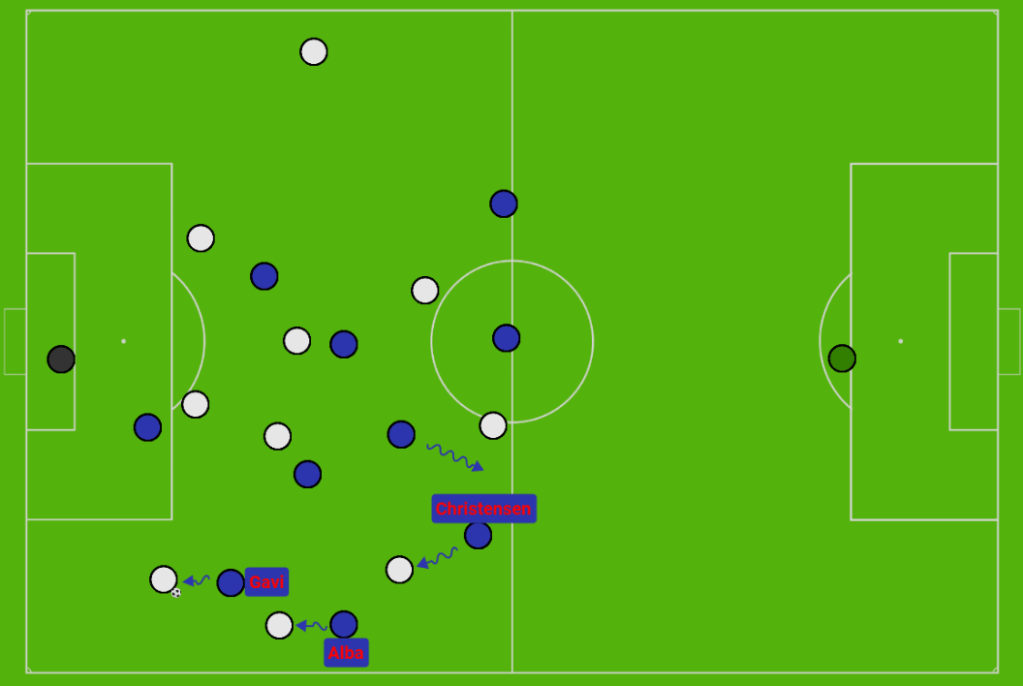
The shape in those pressing cases will typically be more of a 4-4-1-1, with Pedri shifting up into more of an attacking midfield role. Stability is pivotal in this phase, and having Busquets and de Jong in the heart of midfield means that stability is frequently provided.
The one downside would be that if the press is efficiently broken, their high line can leave space in behind to exploit and infiltrate. They are allowing high quality shots to be created (the fourth highest xG/shot conceded in the league), but luckily ter Stegen always remains on the case. The German currently boasts the highest save percentage in the league, a stunning 88.7%.
Conclusion
Embed from Getty ImagesBarcelona are roaring their way to Xavi’s first league title in Spain, in what is expected be a memorable season for the Catalans. With the Supercopa de España already won, Blaugrana have their sights set on La Liga and the Copa del Rey to complete what would be a fine double in Spain. The Catalan giants will have their sights set of restoring the club back to their UEFA Champions League winning ways in the future, but for now, Xavi is building toward something special in the future.
So there it is! Our analysis of FC Barcelona this season, written by Charlie Ellis. Be sure to check out more La Liga content, Team Analyses, and follow on social media @mastermindsite. Thanks for reading and see you soon!
YOU MIGHT ALSO ENJOY…
Míchel – Girona – Tactical Analysis
After nine games of the 2023-24 La Liga season, Míchel’s Girona have won seven games and lost only to Real Madrid. This puts them second to the current title favourites, and in for the season of a lifetime. Here is our tactical analysis of Míchel’s Girona in 2023-24, and how they’ve put on such stunning…
Game of Numbers #25 – Barca’s midfield diamond & Frenkie de Jong in defense
Barcelona have started the season off unbeaten, but it hasn’t been the two most convincing performances from Xavi Hernandez’s team, as they continue to adjust to the array of midfield talent they have at their disposal. Here is Game of Numbers #25, starting with Barcelona’s use of Frenkie de Jong as a centre-back.
Why İlkay Gündoğan is perfect for Barcelona
After a UEFA Champions League winning campaign, a considerable loss for Guardiola’s Man City becomes a remarkable gain for Xavi’s Barcelona. İlkay Gündoğan had been a stalwart in the treble winners’ eleven for the past season, and for good reason. He’s one of the most technically and tactically gifted footballers on the planet, and became…





One thought on “Xavi Hernandez – Barcelona – Tactical Analysis (2022-23)”